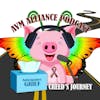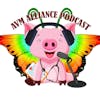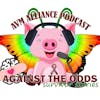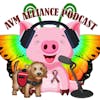SE 2: Episode 3: The Doctor is IN: Therapy for Kids
Happy October to all our listeners. October is Brain AVM Awareness Month. As a reminder, A brain AVM is a tangle of abnormal arteries and veins, that do not have the needed capillaries in between the connections. If you would like more information on Brain AVM’s: AVM Alliance, an official non-profit, now has its own website www.avmalliance.org. On it you will find lots of information as well as personal stories. Last month’s Part two episode started with terms found on radiology tests doctor’s order and dove a bit into epilepsy, EEG’s and stroke in infants. Today’s episode will end the series with questions about stem cells and other therapies and programs for kids who have suffered a stroke. We will end today's podcast with a "Things to Think About” takeaway lesson from a special children’s book.
Happy October to all our listeners. October is Brain AVM Awareness Month. As a reminder, A brain AVM is a tangle of abnormal arteries and veins, that do not have the needed capillaries in between the connections. If you would like more information on Brain AVM’s: AVM Alliance, an official non-profit, now has its own website www.avmalliance.org. On it you will find lots of information as well as personal stories. Last month’s Part two episode started with terms found on radiology tests doctor’s order and dove a bit into epilepsy, EEG’s and stroke in infants. Today’s episode will end the series with questions about stem cells and other therapies and programs for kids who have suffered a stroke. We will end today's podcast with a "Things to Think About” takeaway lesson from a special children’s book.
Webpage: https://www.avmalliance.org
Go Fund Me: https://www.gofundme.com/f/avmalliance
Our FB Page: https://www.facebook.com/AVMAlliance
Our FB Group: https://www.facebook.com/groups/325321586185434
Instagram: https://www.instagram.com/avmalliance/
TikTok: https://www.tiktok.com/@avmalliance
YouTube: https://www.youtube.com/@avmalliance
Personal Blog: https://www.caringbridge.org/visit/kylerlewis
Twitter: https://twitter.com/avmawareness
Raylene Lewis:
Hi there, and thank you for joining us on AVM Alliance, a pediatric podcast for families and friends whose lives have been affected by traumatic brain injury, rare disease, brain disorders, or stroke. The purpose of this podcast is to focus on the kids side of brain injury with honest talk, news, information, and discussion for our community. Being a parent of a medically complex child is an extremely difficult path to suddenly find yourself on. I'm Raylene Lewis, and my son Kyler suffered a hemorrhagic stroke at age 15. Thank you for joining us. Happy October to all of our listeners. October is Brain AVM Awareness Month. As a reminder, a brain AVM is a tangle of abnormal arteries and veins that do not have the needed capillaries in between the connections. Capillaries are So very important because they slow blood flow between high pressure arteries and low pressure veins. Capillaries also deposit the oxygen from blood to the surrounding healthy brain tissue. Without the capillaries, blood is moving at a high pressure from arteries into the veins. which causes the vessels to stretch beyond their normal size. This weakens them and increases the risk of a vessel to tear, which would spill blood into surrounding brain tissue, thus causing a hemorrhagic stroke. Please help us spread the word this month about brain AVMs and brain vessel disease. Stroke has no age limit. And if you would like more information on Brain AVMs, AVM Alliance, an official 501c3 non profit, now has its own website, avmalliance.org. On it, you will find lots of information, as well as personal stories. We are also excited to announce that you will soon be able to find the link to all of the webinars from the Pediatric Stroke and Brain Injury Education Group under our For Parents Help Desk. Full Organizations section. Their educational series brings together families and professionals to learn together how to support children to thrive after stroke or brain injury, and they are constantly offering new ways to enhance a child's development at home, in school, and in the community. Also, we wanted to let our listeners know there is currently a vein of Galen malformation genetics research study going on. Parents whose child has received a VOGM diagnosis and agree to participate in the study are provided a special Q tip to swab their cheek and the cheek of their child. If you would like more information, you can find it on the AVM Alliance website under Research Studies or email us info at avmalliance. org and we will send you the link to sign up for the study. And for our international listeners with a VOGM diagnosis, yes, you are also eligible and encouraged to participate. The Q tip samples can be sent to you overseas. And before we get started with our final interview on our The Doctor Is In series, Going over questions parents submitted to this podcast for our medical professional, I wanted to let everyone know that our 2023 Hope on the Horizon fundraiser is in full swing. In order for AVM Alliance to be able to continue this podcast, The website and the services we offer, we desperately need the support of our community. Please go to our website where you will find a donate button or learn more about us and donate by going to brazosvalleygives. org slash avmalliance or find us under nonprofits under GoFundMe. AVM Alliance is a 100 percent volunteer non profit organization, and you can see your gift's impact by following us on social media. Last month's Part 2 episode of our Doctor Is In series continued with terms found on radiology results that doctors order and dove a bit into epilepsy, EEGs, and stroke in infants. Today's episode will end the three part series with questions about stem cells and other therapies and programs for kids who have suffered a stroke. We will end today with a things to think about takeaway lesson from a special children's book. With me today, I have the director of the Pediatric Stroke Program with the McGovern Medical School at UTHealth Houston, Dr. Stuart Frazier. Dr. Frazier, thank you for joining us. I really appreciate the invite. After, you know, stroke, there's different stem cells. Which one is the best type? Do they work for stroke? What have you been seeing?
Dr. Stuart Fraser:
So there's a lot of different types and there's, there's a lot of research that's going on with stem cells and stroke, including here at UT. The floor below me, a collaborator, Dr. Savitz has been working on that for a long time, trying to find ways to use stem cells to help stroke survivors. The mechanisms are complex and I am not the world's foremost stem cell expert. I'll try to give the second or third grade version and most of it will be right. As of yet, we don't have any level one or I say top level evidence that we have found a way to use. stem cells to improve outcomes in stroke. I think there is a way. I don't know what it is yet. And they're working on that here at UT. They've worked on it in the Netherlands. We have been working on trying to set up trials at least to try to find ways to help kids who have had stroke with stem cells. I can say as The best evidence so far points to, they, when stem cells would be helpful is probably administration right when the stroke happens. We don't have a lot of strong evidence that two, three, four years later, they'd be able to make brain cells regrow or change in, in a meaningful way. So that would be the big thing I'd say to, to caution parents that are out there. Most of the trials that I've seen have that. have had promising preliminary results have been looking at right when a stroke happens. We are giving stem cells and we have shown that it's safe. And there's also a little bit of evidence that maybe this can reduce some of the injury that happens right at stroke.
Raylene Lewis:
Define right when within the first six months, within the first six weeks, within the first six hours. Usually
Dr. Stuart Fraser:
within the first couple of days. We break it up into time periods. There's the hyper acute phase where we're still talking about saving brain cells that are at risk but haven't died. That's the first few hours. If you finished all your saving steps you might now be in a phase where you're trying to prevent secondary injury to brain cells that are near the brain cells that already died. So preventing seizures, keeping the patient's blood pressure up so that they're getting a good perfusion to the rest of their brain. I'm starting medicines to thin the blood often so that we're not getting more blood clots. And that's the first couple of days. Then you start talking about recovery and reorganization of brain cells. The first few months seem to be very important, but in my experience, and I 30. You can make changes to your brain years after your stroke. It just may not be as easy as right at the beginning.
Raylene Lewis:
Sure. Same thing for kids, right? It's easier for kids to learn multiple languages when they're young. It's just the way the brain works. I think kids tend to recover a little faster
Dr. Stuart Fraser:
than Yeah, yeah. Yeah, there are sort of rules of thumb for recovery, but about, Oh, you can't You know, easily recover language after six years old or 12 years old or whatever my experience. Kids break those rules all the time. So I don't worry about them. I say you, you do you, you're going to figure it out.
Raylene Lewis:
I love it. Okay. Now, in general, continuing with therapy, how do parents find organizations or hospitals that offer specialized rehab programs after the initial rehab was done? And what I'm talking about is in particular, Boost programs, like we had one mom who just finished a month long constraint therapy program for her kids. And another one did a four week LSVT speech program. How do we know what's out there? How do we get connected with those?
Dr. Stuart Fraser:
Yeah, that's tough. You have to ask you, you have to ask people that you trust. So current therapists, your doctors, if you're lucky enough to be at a place that has a specialized stroke program or specialized stroke therapist, she's probably going to, he or she is probably going to be in the, in the know on those sorts of things. I encourage parents to join local and non local parent support. Groups and you know your kids to when they're ready. It's nice for them to get in contact with kids. You've been through the same thing that they can. They can also tell you. I don't know of a centralized registry of special constraint programs. I know, you know, we know what's here in Houston because Well, our therapist Anna checks for me and you guys tell me so we keep a running list. If research is something else that you're interested in, oh, we want to try research therapy programs. You can also go to nationalclinicaltrials. gov. You can type in the keywords pediatric stroke and you can look through yourself. Parent websites are also great. And then there's two, I'm not going to have to put in a plug for AVM Alliance because we're on the AVM Alliance podcast, but I'll also put, I'll put in a plug for. the International Pediatric Stroke Organization. They're wonderful and they try to keep as an up to date list as they can. And then here at my desk the International Alliance for Pediatric Stroke. You can go to IAPediatricstroke. org and just learn a lot about what's out there. Recognize that a lot of these programs are great. Not all of them are paid for by insurance, which is rough. So you sort of have to figure out what is feasible and best for you and your child.
Raylene Lewis:
Now, speaking of that at UTHealth you guys are running a couple of programs there, right? Do you want to tell me about those real quick? Sure,
Dr. Stuart Fraser:
sure. We'd be happy to. So we, we are recruiting for two rehabilitation trials for kids with stroke right now. So one of them is iAcquire. So iAcquire is a national study with multiple centers participating. Where kids who have a stroke right at birth, just like we were talking about, and who develop weakness on one side or the other can enroll in the trial where they're offered therapy. It's an intensive therapy program. Kids get anywhere from three hours a day to six hours a day of therapy, and they do what's called constraint induced movement therapy, which we were talking about earlier. Where, you take the quote unquote strong arm or good arm. And you put it in a cast for three weeks and make them use the other
Raylene Lewis:
one. I didn't realize that's what all was
Dr. Stuart Fraser:
involved. Yeah, so there's a lot of different levels of constraint. I, I am a big proponent of you can retrain your brain intensive works. And so the study is for toddlers until or eight months old until 36 months old. They can be enrolled and participate in the program. Where again, they, they get one month of between three and six hours of therapy per day. It is a research program. So you'd, you have to ask parents about, you know, what the, what they saw in terms of the benefits. Cause I'm not supposed to tell you how great and wonderful it is, but I do think that it was very well thought out and we had a lot of good data before setting it up on what kids need to achieve their maximum potential. And we found that The brain is very plastic during the toddler years, and it's really worth trying to try to reduce disability as much as we can for when you get older and you're playing soccer and going to prom and getting your first job and all that stuff. It helps to have a little bit more strength in one ear.
Raylene Lewis:
Okay, and was there a second one
Dr. Stuart Fraser:
also? There was, yeah. So, the second study we're doing is a newer study that is coming just out of, out of UT Health. So, we talked about there is a, a rehabilitation therapy program going on for toddlers who had a stroke right at birth. To date, there haven't been any rehabilitation trials that focused on kids who have weakness of one side of the body from a stroke that happened after birth. So, we started that here, and we just opened about three weeks ago for enrollment. where we are offering rehabilitation therapy on a research basis where patients do about 10 hours of it and at the same time they're receiving this adjunctive treatment that's called transcranial direct current stimulation. So that is a technique that is being studied in the adult stroke world, in the CP world, but it hasn't been done for childhood stroke yet, where these little electrodes or sponges, we call them, go on the brain and they release a very, very, very small amount of current. The idea of which is to try to encourage brain cells to be a little bit more responsive to therapy for the next couple hours after the current is released. It's been done in hundreds of kids and thousands of adults never had a major adverse event. And so we saw and thought, wow, this seems really safe. And a lot of the data seems to suggest that it's effective. Why aren't we offering this to? Kids who had stroke. So what's the age range on that? That's for children that are age five to 19 years old. So anyone who had a stroke about one month after they're born or later, who is five and 19 and has weakness on one side is potentially able to
Raylene Lewis:
participate. Okay, and just so anybody who's listening will know, I will include links for people who, if they're interested in knowing more about either one of these programs where they can get to. The older program, you kind of have to be in the Houston or surrounding area, but the iAcquire is more broad based, right?
Dr. Stuart Fraser:
So, yeah, iAcquire is very broad based. There's a lot of sites all over. You can look up the list and find the one closest to you. We are, unfortunately, the only site in Texas and there's, there aren't any sites within 500 miles of us. So we have had people that have have driven in or flown in from outside the state for it. And of course, we're always, anyone who's able to come, we're, we're happy to work with you.
Raylene Lewis:
Perfect. So you can fly in, it's about 10 hours of this therapy and then fly out. Yeah. So
Dr. Stuart Fraser:
for, yeah, so for, I acquire, it is, it's about a month long where you'd have to be in Houston. And then there's a couple other visits after that. For TOPS, the current version is. About a week, so you'd have to come in maybe the Thursday or Friday before, stay the week and you'd be able to leave the Monday or Tuesday afterwards, if you were flying in from outside of Houston.
Raylene Lewis:
Okay, and TOPS is ages 5 19
Dr. Stuart Fraser:
years old, yes. Okay. so
Raylene Lewis:
one last big question for the day. Tell us, as parents, is there anything in particular that is a do or don't do when we're in your office and being seen with the kids? Like, give us a couple of just, you know, general rules of thumb that say, gosh, I hate it when parents do this, or gosh, I really wish parents would come with like this prepared, or, I
Dr. Stuart Fraser:
mean... I love all of my patients and all of their parents. They would never annoy me. You know, my experience is... This is a strange thing to have happen. No one expects it when it happens. A stroke, a bleed, an ischemic stroke, it just happens. And every parent has PTSD that I meet. Because it's like that. It's a lightning strike. And it's dramatic. And it stinks. It's really rough. I think I, sometimes I have parents that they don't want to inconvenience me too much. Or they don't ask too many questions. And what I tell people is. This is my job. I really care about this. So you can, you can ask me, you can write it down beforehand. If you want to email about it, we can email about it. I'm happy to do that. This is, this is what I really care about. This makes me really happy taking care of kids that, that have had this happen to them because they deserve it. And someone has to do it. So it might as well be me. So if you're wondering what to do, I'd say, Just come ready to ask what you feel you need to know to help your child and we will try to help your child. I love it.
Raylene Lewis:
That's the perfect answer. And speaking of a parent who definitely has PTSD from their kid's diagnosis and then all the problems even after that, you know, trying to get him better. I know we're worriers. We're natural worriers. And so in addition to worrying about our kid. I think as parents, we feel like, you know what, we need you, the specialists, way more than you need us, so we try to be extra careful to keep you happy.
Dr. Stuart Fraser:
Well, that's sweet of you guys. And I couldn't ask for a better group of kids to take care of and a better group of parents to take care of them. So you just keep doing your best and be the advocate. I don't think I've ever had a parent be mean to me in a stroke interaction because... What are you going to be mad about now? Like it, you know, everything's different. This is so dramatic and so important.
Raylene Lewis:
Well, one thing I'll say for sure about every stroke parent that I've met is when people, you are around other parents who complain about things or who are unhappy about things, it's like, hmm, perspective, you know, things that should bother me or bothered me back in the day pre stroke are kind of not important
Dr. Stuart Fraser:
anymore. Yeah, right. Exactly.
Raylene Lewis:
Well, thank you so much for coming on and talking with us and answering our questions and taking time out of your day. It's sincerely appreciated.
Dr. Stuart Fraser:
Yeah. Yeah. I love the opportunity. Thank you so much for inviting me. Let me know if there are follow up questions. I'll try to do my best. Some of those were, some of those were tough. I'm not going to lie. You, you have some sharp cookies on the, on the other end of that keyboard. So let me know if anything else comes up. Okay. We would love to
Raylene Lewis:
have you back. Thank you so much for joining us.
Dr. Stuart Fraser:
Thank you.
Raylene Lewis:
The focus of this month's things to think about is based on the children's book. What do you do with a problem? Written by Kobi Yamada. Problems shape us, push us, and help us to discover just how strong. Brave and capable, we really are. Even though we don't always want them, problems have a way of changing us in unexpected ways. The more we worry about our problem, typically the bigger the problem becomes. And a problem is not something we can typically hide from or avoid long term. In fact, trying to do so can often make things worse and make us feel unwell. But when you decide to face your problem, you might also discover that most problems also have an opportunity for something good. And when you find it, you learn something about yourself, too. What we choose to do with our problem is up to each one of us. Thank you, Kobe, for this lesson. And as always, if you have questions or have a topic you would like to hear about, don't be shy, share it in the comments and let us know. And if you liked what you heard today, please go online and rate this podcast. Remember, you're never walking this journey alone. Take care, y'all.
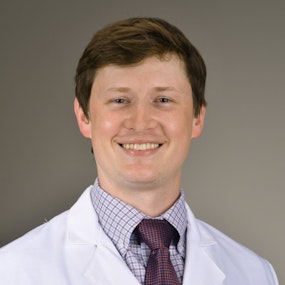
Stuart Fraser
Pediatric Stroke Doctor
Dr. Fraser is a pediatric vascular neurologist and an assistant professor of child and adolescent neurology at the University of Texas McGovern Medical School in Houston, Texas. Dr. Fraser is board certified in both pediatric neurology and vascular neurology, and the director of the pediatric stroke program at the University of Texas McGovern Medical School. Dr. Fraser attended medical school at the University of Texas McGovern Medical school, and stayed on for a combined residency and fellowship in pediatrics and child neurology, where he also served as chief resident. Dr. Fraser then completed an ACGME-eligible vascular neurology fellowship with Memorial Hermann Hospital before joining faculty as an assistant professor of pediatric neurology. Dr. Fraser’s clinical practice includes attending on both the pediatric neurology primary service and the adult stroke service, and his outpatient practice specializes in treating cerebrovascular disease in infants, children and young adults. Dr. Fraser is the chairman of the Texas Governor’s EMS and Trauma Pediatric Stroke task force, and has spoken both nationally and internationally on pediatric stroke acute management as well as outcomes and recovery. Dr. Fraser's is passionate about advocating for children wtih stroke, and is dedicating his career to improving the lives of children and adolescents who have suffered from stroke.





























